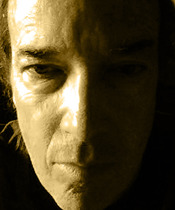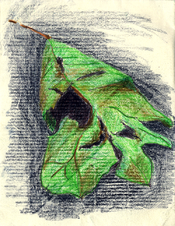Sunset, Thursday, 24 September 2009
 William Theodore Van Doren. Sunset from Stony Point, Albemarle County, Va. Oil on watercolor block, 16 x 20.
William Theodore Van Doren. Sunset from Stony Point, Albemarle County, Va. Oil on watercolor block, 16 x 20.
It’s been steamy today, and my attention turns, down in front of my view of the sunset, to the huge circular garden in the back yard, which, as I’ve previously explained, has been neglected and left dormant this year – which actually means, going crazy with weeds this year. But not just your ordinary waist- and shoulder-high weeds – I mean jungle-like weeds – violacious weeds. (I love that word – encountered while proofing a medical journal, where it described a skin eruption. Scared me to death.) Pokeweed, of course – spectacular, almost tree-like pokeweed some nine feet tall, now a gorgeous toxic bright purple from stern to stems, hanging with the dark purple berries we painted our faces with as kids. Thistles. Yet another volunteer peach tree. New blackberry hedges. But the most prominent invader – literally an invasive species – ailanthus trees, three of them, at least 15 feet high. How something so widely despised would be called Tree of Heaven escapes me; around here it’s commonly known as Paradise Tree.
The southeast Asian origins of the ailanthus suit the day, and its jungle leaves make me think of the paintings of Henri Rousseau – yes, the one they called ‘Le Douanier’. What a beautiful painter. Alongside my setting sun (although mine is overtaken by nearby storms), Henri adds a lustrous silver moon. At the center of the garden, perhaps a savage nude with lionesses. The garden chokes with tropical vegetation. The Blue Ridge reverts to its ancient volcanic past and issues plumes of smoke.
 Thursday, September 24, 2009 at 08:14PM | by
Thursday, September 24, 2009 at 08:14PM | by  BVD | in
BVD | in  Print/Cards Available,
Print/Cards Available,  Sunset Paintings | tagged
Sunset Paintings | tagged  Blue Ridge,
Blue Ridge,  Henri Rousseau,
Henri Rousseau,  Le Douanier Rousseau,
Le Douanier Rousseau,  ailanthus,
ailanthus,  paradise tree,
paradise tree,  pokeweed,
pokeweed,  tree of heaven,
tree of heaven,  trees | | Comments Off
trees | | Comments Off 













Coal and the Power Lines
The ominous, vaguely bituminous look of last night’s sky inspires me to add this as a note here.
Today I was happy to find, up in the branches of a black cherry tree, a few wild blackberries ready to eat, along with just-ripened black cherries. It reminded me of one of the most frequently asked questions in American life: “Would you like to try our combo today?” Finally, I was able to say yes.
But the scarcity of blackberries around here, which I have previously attributed chiefly to the land-clearing activities of crews under contract to Rappahannock Electric, also reminded me that I had just received a most unfortunate mailing from that utility.
REC urged me to call my Senators and urge them to oppose the climate change bill already passed by the U.S. House of Representatives. The bill, REC warned, might make electricity more expensive.
Well, I guess so! Any time you can’t just burn any old cheap dirty coal you want to, anywhere you want, something’s gotta give. (On the subject of coal and climate change, this article from The New Yorker is worth registering in order to read, and I believe this blog item doesn’t require signing in.)
As a customer-member (incredibly tiny minority shareholder) of the Rappahannock Electric Cooperative, I was not happy to see my money being spent in this lobbying effort. If electricity’s going to become more expensive, let’s not waste funds now on futile efforts aimed at halting human progress.
And despite the importance of coal to the economy, I thought I would register my dissent partly in the name of my grandfather, a Czechoslovakian immigrant who was a coal miner in Pennsylvania. I think working in the mines was probably not the primary cause of his very unpleasant death from throat cancer, but I doubt that it helped. I’d like to think that Grandfather Bezilla would be on my side of the climate change issue today.
After the blackberries and cherries, I saw something on my walk that made me feel a little better about this year’s aggressive land-clearing. Along the track we call the Power Line Road, growing out of the Nagasaki-like devastation, two bright green paulownia trees were shooting up like rockets – already some eight feet high, with enormous healthy leaves as big as the ear of a young elephant. Despite their rapid rate of growth, these paulownias could not come close to endangering the lines if they grew another 150 years. That may not save them when the crews come through again, but in the meantime – and regardless of how botanists may feel about them as an exotic species – their beautiful attempt to flourish is the best revenge.